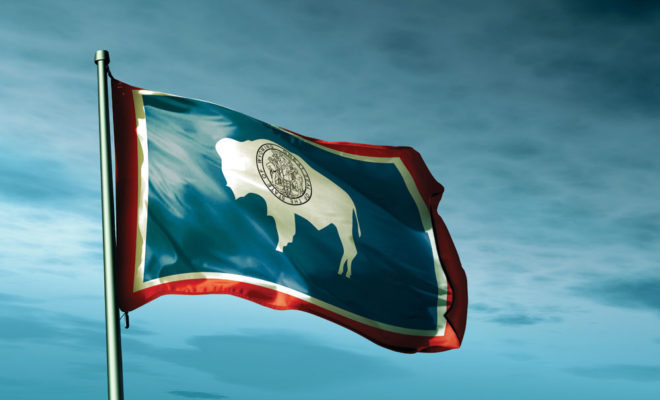Whether it’s on a bumper sticker, the front of a t-shirt, or waving from a banner way up above, we all know and love the Western-facing bison on the blue field of our state flag. To non-locals, the Wyoming flag may seem simplistic. But for those who live in Wyoming, it is so much more. Our state flag is a symbol of our pride and a quintessential piece of Wyoming’s history. And, if you didn’t already know, this year marks the 100th year anniversary of the adoption of Wyoming’s state flag – giving us a grand reason to celebrate our heritage.
On January 31, 1917, the Wyoming state flag was officially adopted. The state of Wyoming was admitted as the 44th state in 1890 and went without a flag for almost thirty years. It was one of the last states to claim an official state flag, but it’s no less important. State flags are meant to show the country and the rest of the world our values and identity. Each state has their own history and collective persona, and Wyoming’s flag is no different. Our flag represents the state’s pride, its testimony, love of the land, and dedication to wildlife and its people.
Take a moment to gander at Wyoming’s flag. On the surface, you’ll see a white bison silhouette branded with the Wyoming state seal. Take a deeper look and you’ll see that every single part of Wyoming’s state flag has a meaning and a purpose. For instance, the red border that surrounds the flag represents the original Native Americans who inhabited the land, and the blood of the pioneers who fought for their lives to reclaim the soil back in 1869. The white border symbolizes purity and uprightness of the state of Wyoming; the blue background represents our beautiful blue skies and our cascading mountains. Maybe it is simply a patriotic coincidence, but the colors of our state flag mirror that of our nation’s flag.
The meaning of Wyoming’s state flag doesn’t stop there. You can’t miss the larger-than-life white silhouette of a bison smack dab in the middle of the flag. Yes, we all know and love our great bison, but so does the rest of the country. In fact, in May of last year, the American buffalo (rightly, bison) was named the official national mammal of the United States.
Millions of bison once roamed North America and were coined the monarch of the plains, playing an essential role in shaping the natural ecology of the Great Plains. Sadly, as more people began to settle in the western plains, bison were hunted to near extinction for sustenance, their prized fur, and for game. What was once millions of bison roaming the lands, alarmingly decreased to approximately 1,000 wild bison by the year 1900. Fortunately, in the early 1900s, conservationists and ranchers began to see the importance of the bison to the region’s ecosystem. It took a lot of hard work and grit to protect them but was supported by the installment of protected federal lands, providing bison the breathing room to increase in numbers. The American bison was luckily brought back from the brink of extinction.
The state seal is also present on the state flag and holds a lot of meaning for the people of Wyoming. The woman on the seal holds a staff with a banner marked with the words “Equal Rights” to represent the equal political status of men and women. Wyoming has valued equality for a long time and was the first state to grant women the right to vote in 1869. From that point on, we are also known as The Equality State. The state seal also has two men representing cattle ranchers and miners. They stand behind two pillars draped with the words “Livestock,” “Mines,” “Grains,” and “Oil,” symbolizing Wyoming’s wealth in natural resources. The two burning lamps are a symbol for the Light of Knowledge. Wyoming’s state seal is located on the heart of our flag, symbolizing our honor, heritage, and regional pride.
So, who designed the flag?
Back in 1916, the professor of Political Economy at the University of Wyoming and state advisor for the Daughters of the American Revolution, Dr. Grace Raymond Hebard, suggested a flag be designed for the state. Of course, everyone thought this was a great idea. An even better idea was to hold an open competition for the design with a $20 prize money, and that’s exactly what the Daughters of the American Revolution did.
The winning design was chosen at the Daughters of the American Revolution’s state conference in Sheridan in the summer of 1916. They promoted their open competition throughout the state of Wyoming. Wilbur Parke Keays of Buffalo noticed the advertisements and suggested to his daughter, Verna, that she submit a design. It was $20 after all. Verna had just graduated from the Art Institute of Chicago, studying Design and Decoration, so she was a shoo-in.
Stereotypical of a procrastinating teenager, Verna blew off the project because she had a friend visiting from out of town. However, Verna claimed that she was in a deep sleep and suddenly woke up in the middle of the night with inspiration for the perfect design of the state flag. She went to work and recreated her dream-inspired design and submitted it as one of 37 entries. Lo and behold, Verna won the contest with her design. She was then invited to the conference to speak on her design and to accept the $20, and the rest, as they say, is history.
The design, as well as a bill, was presented to the Fourteenth State Legislature and officially adopted and passed on January 31, 1917. Everyone in the state of Wyoming was proud of their new state flag. Governor Robert D. Carey signed the bill into law, and the State Legislature even voted to have folders printed with the design to be distributed to every school-aged child in the state.
For the last 100 years, people of Wyoming still uphold the virtues of our state flag: to value equality, our wildlife, the mining and oil industries, and our history. As this year marks the 100th birthday of Wyoming’s state flag, 2017 is sure to be a year filled with pride and honor for all things Wyoming. So, let’s celebrate our great state by flying our flag sky high for all to see, and by continuing to make time to do some of our favorite things in Wyoming, like hunting, hiking, fishing, star gazing, cattle ranching, rodeos, and so much more.
Say it with me, “We live in Wyoming – and we’re damned proud of it!”

